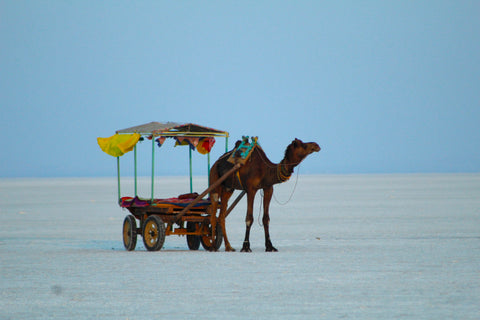News
Journey to Kutch Gujarat

The kachchh, popularly known as Kutch is so unique and vibrant. The Kutch is surrounded by gulf of kutch, Arabian Sea on one side and Rann of Kutch on the other side. The grasslands, the ocean and the salt dessert combination makes Kutch a memorable experience for the travellers. The locals say Kutch is land of migrants who have come from different parts of the world and has made Kutch their beloved home.
There is a wide range of communities and cultures. When you go around Kutch you can see the temples, gurudwara, mosques and jain temples within a kilometre of each other, the people respecting the other religions beliefs and continue to exist in peaceful atmosphere. The cattle herder communities came from Baluchistan and settled north of Kutch around grasslands. The Hindus settled south of Kutch along the coastline. The migrants communities settled in north brought the crafts from Persia, Turkey and Central Asia.
When we entered the main city, our travel agent assigned local transport owner Mithul ji started telling the tales of Kutch. One tale which left a huge impression on me is the tale of reconstruction of air strip of Bhuj airforce base by 300 local women in 1971. The air strip was destroyed by Pakistani bombers who had dropped 14 Neelam bombs on the night of December 8th, 1971. As the officials amid the crisis couldn’t wait for long, they sought help from the locals. 300 women from Madhapur village were summoned and assigned to build air strip within 72 hours. When Mithul ji explained how the women worked day and night in between air strikes gives you goosebumps. After the reconstruction when the Indian airforce took off, the city celebrated, congratulated and saluted these women. There is a memorial dedicated to these women in Bhuj city.
On our first day of Kutch visit, we explored the local market and popular shops visited by the tourists. To our dismay we could only find imitation of the Kutch crafts at very cheaper rate which was attracting lot of customers. Hours of hard work the local women put to do the extensive variety of embroidery can be done by machines in few minutes and sold at lesser price.
On our second day of visit we decided to visit the villages around Bhuj to know the history of the local communities and their crafts. We visited Sanjot, Ludia, Nirona, Khavda, Bhujodi, Ajrakhpur.
- Sanjot, Leather art
The Meghwar community artisans are said to be migrated from Rajasthan to Kutch. Meghwars were making sturdy shoes for the Maldharis and decorative items for the their cattle from the hide of the dead cattle. Now, they make most of their products from Buffalo hide and rest of the products from sheep and goat. We will create our own product line by next year.

2. Ludia, Embroidery
According to Srujan Organisation who has done Extensive Research into 12 communities and their unique 50 styles of embroidery, every embroidery style has history and different type of expression through threads. We want to get these unique embroidery done on our other fabrics we source from various states.

- Nirona, Rogan Painting
We met a family who has been doing this Rogan Painting from 300 years, it is an ancient traditional art which was practiced few hundred years ago. Now, The Khatris of Nirona are the only one family who has preserved the art and still practicing it. The art is unique and only the specialised hands can do this intricate complex art. We were fortunate to witness the process in detail.

4. Nirona, Lacquered wood and metal bells
Lacquered wood craftsmen use natural colours and castor oil to design the handle of wooden cookware. It was a great experience to watch and record the intricate design they do with their practised hands with great ease. We also met one of the families who crafts metal bells, the eldest of the family showed us the mechanism of creating a bell and how they create different music from each bell they craft. From the start to the end, his enthusiasm to show us the process was a pleasure to watch and learn.
5. Chavda, Ajrakh Printing on Home furnishings and Pottery
In Khavda village they do Ajrakh Printing on bedsheets, pillow covers, table tops and other home furnishing materials. Final product will be ready after the fabric goes through eight steps of process. We also got to see the famous Mud Work of Kutch and other Products of Pottery. We were awed by the vast varieties of art work.

- Bhujodi, Kachchh weaving and Embroidery
We met the women group who does Kutch Embroidery on our Kutch bags and other products. We interacted with them to know their routine and their art work and its history. We met a Weaver who uses natural colours to weave and who felt the need to improve his skills and got admitted to fashion designing course. He is now guiding other weavers to weave the products according to the current market trends and customers choices and preferences. He has worked with top notch designers of Bollywood as well. He is the 7th generation weaver in his family. We want to explore more in this section next year.

- Ajrakhpur, Ajrakh Printing
Mithul ji took us next to the Ajrakpur, Ajrak - Aaj Rak (keep it today) as explained by Ismail Khatri ji whose family has been doing Ajrak printing work from 400 years. It takes 15-20 days to make a Ajark saree and close to 20 people work on it. The fabric goes through 8 major steps in Ajrak printing and they prepare the natural colours from various natural elements such as turmeric, iron, jaggery, Indigo etc.

We will be exploring more Kutch crafts this year. Watch out this space for more.
Published by
Shruthi Shivanand
Gaatakatha travel diaries.






